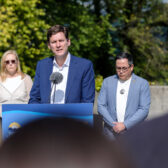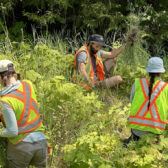Clearing the air over a vital project
If the air seemed cleaner in the city of Nelson over the last few months, you would be right.
There was a decrease in greenhouse gases emitted by some corporate City operations in 2010, according to a report prepared by the City’s corporate climate action coordinator.
Fiona Galbraith said the decrease was attributable to a warmer winter at the start of 2010, and it will be challenging to see as time goes on the result of action versus weather as things return to normal.
“The weather played a significant role in the 2010 results with warmer than average temperatures and below average snowfall, but we are also seeing the results of energy conservation efforts made by individual departments prior to the implementation of the plan,” she told City council Monday night at their committee of the whole meeting.
Vehicle fleet and buildings together make up 90 per cent of the greenhouse gas emissions produced by the City, said Galbraith. In the fleet there was a decrease in emissions in 2010 due to a low snowfall year, meaning less fuel was burned.
Energy savings from projects completed last year have already been realized at the Nelson Fire Hall and Nelson Hydro, said Galbraith, with energy savings of $2,200 and $3,000, respectively, of yearly savings.
Nelson Hydro performed a lighting retrofit on the downtown Parkade, achieving a 53 per cent reduction in electrical usage.
At the Fire Hall, a number of building retrofits were implemented, such as a trip switch that shuts down the heating system in the vehicle bay area when the bay doors open, resulting in a 20 per cent reduction in energy usage.
That equated into a seven tonne reduction in greenhouse gas emissions in 2010.
Retrofits will take place on City Hall and the Library and Police building this year, with a Civic Centre energy audit to be completed by the end of the year.
Starting this month the City’s fleet will begin using bio-diesel — a five per cent blend — and will continue until September of each year following. Last year diesel usage was down, but gasoline consumption remained the same, said Galbraith.
“We’re further ahead as to where the buildings are,” she said about energy savings, “but we have more to go with the fleet.”
“All of this is a bit of common sense, stop using more,” said Mayor John Dooley.
The total capital cost estimate for the 2011 phase of the greenhouse gas reduction plan is approximately $450,000, with an estimated yearly energy savings of $72,000.
Last year was the first year of implementation of the Greenhouse Gas Reduction Plan. Galbraith said the full impact of the 2010 projects the City undertook will not be apparent until the 2011 inventory is complete.
- Nelson Hydro general manager Alex Love said the City’s operation produced roughly 1,300 tonnes of CO2 in 2010, with the goal of 800 tonnes by 2025.
- To meet greenhouse gas reductions goals, however, the City will have to buy some carbon offsets in 2013.
twitter.com/#!/TheNelsonDaily

























